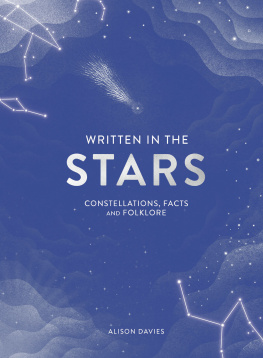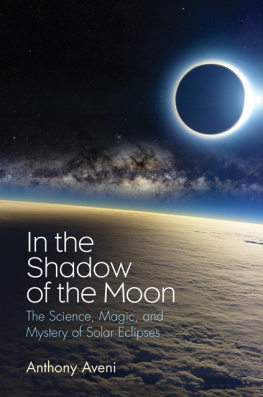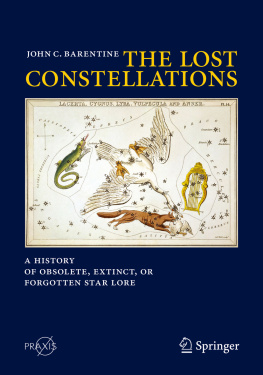Anthony Aveni - Star Stories: Constellations and People
Here you can read online Anthony Aveni - Star Stories: Constellations and People full text of the book (entire story) in english for free. Download pdf and epub, get meaning, cover and reviews about this ebook. year: 2019, publisher: Yale University Press, genre: Romance novel. Description of the work, (preface) as well as reviews are available. Best literature library LitArk.com created for fans of good reading and offers a wide selection of genres:
Romance novel
Science fiction
Adventure
Detective
Science
History
Home and family
Prose
Art
Politics
Computer
Non-fiction
Religion
Business
Children
Humor
Choose a favorite category and find really read worthwhile books. Enjoy immersion in the world of imagination, feel the emotions of the characters or learn something new for yourself, make an fascinating discovery.

- Book:Star Stories: Constellations and People
- Author:
- Publisher:Yale University Press
- Genre:
- Year:2019
- Rating:5 / 5
- Favourites:Add to favourites
- Your mark:
- 100
- 1
- 2
- 3
- 4
- 5
Star Stories: Constellations and People: summary, description and annotation
We offer to read an annotation, description, summary or preface (depends on what the author of the book "Star Stories: Constellations and People" wrote himself). If you haven't found the necessary information about the book — write in the comments, we will try to find it.
Star Stories: Constellations and People — read online for free the complete book (whole text) full work
Below is the text of the book, divided by pages. System saving the place of the last page read, allows you to conveniently read the book "Star Stories: Constellations and People" online for free, without having to search again every time where you left off. Put a bookmark, and you can go to the page where you finished reading at any time.
Font size:
Interval:
Bookmark:
Star Stories
Constellations and People
ANTHONY AVENI

Published with assistance from the foundation established in memory of Philip Hamilton McMillan of the Class of 1894, Yale College.
Copyright 2019 by Anthony Aveni.
Illustrations by Matthew Green copyright 2019
by Matthew Green.
All rights reserved.
This book may not be reproduced, in whole or in part, including illustrations, in any form (beyond that copying permitted by Sections 107 and 108 of the U.S. Copyright Law and except by reviewers for the public press), without written permission from the publishers.
Yale University Press books may be purchased in quantity for educational, business, or promotional use. For information, please e-mail (U.K. office).
Set in Minion type by Integrated Publishing Solutions.
Printed in the United States of America.
Library of Congress Control Number: 2019936113
ISBN 978-0-300-24128-0 (hardcover : alk. paper)
A catalogue record for this book is available from the British Library.
This paper meets the requirements of ANSI/NISO Z39.481992 (Permanence of Paper).
10 9 8 7 6 5 4 3 2 1
To
Robert H. N. Ho, whose gift to Colgate University
of the Ho Tung Visualization Laboratory inspired me
to share its sky imagery with a wider audience
Before smartphones, we had books; before books, we had images on cave walls or in sacred temples, their messages enhanced by spoken words now lost. The sky, too, has long been a canvas for telling stories about the meaning of life. Early humans looked for hidden likenesses between the domains of heaven and earthhoping, with the celestial imagery they envisioned, to marry the unfamiliar above to their quotidian lives below. Our contact with the sky humanized us. It encouraged us to use our imaginations to tell stories about who we are.
Like nothing else in the natural world, the heavens were pristine, perfectthe ideal place for the gods to reside. Celestial time rolled on in endless cycles, portending our fate. What better way to peek around times corner into the future? What could be a better medium for creating tales with moral significance than the silent, dependable courses of the stars, coming and going with the seasonsconstellations that heralded births and deaths, reminded us of times of war and prosperity, and memorialized our personal loves and adventures?
Star Stories focuses on the cultural diversity inherent in cosmic storytelling. Constellations and star groups, conceived by a host of ancient and contemporary cultures, will set the stage for a deep discussion of how nature (climate, environment, latitude) and cultures (from hunter-gatherers to empires) have inspired humans to create a wide variety of narratives using patterns in the sky. These stories, from countless generations that came before, are also now ours to ponder and share.
Star Stories

C an you remember lying on the grass on a hot midsummer day? You may have gazed at puffy cumulus clouds roiling in a deep blue sky and imagined familiar forms morphing from one to another: theres a racing car, a baseball outfielders glove, your dogs face. We do the same with geological formations: New Hampshires Old Man of the Mountain, Britains Queen Victorias Rock, Lots Wife in Israel, the Woman of Mali in Guinea, and dozens of sleeping giants and giantesseseven the shadowy likeness of an extraterrestrial face in images of the surface of Mars. Our brains are pattern-recognition mavens. Psychologists call this human knack for visualizing unity among random data pareidolia. The mind tries to resolve the tension that accompanies randomness by attempting to perceive something familiar in an otherwise unfamiliar pattern. These apparitions often exhibit religious overtones: Muhammad in a flame, or Jesus Christ on a tortilla.
A thirty-thousand-year-old painting on the wall of Chauvet Cave in France shows a pair of horned auroch, ancestors of our domesticated cattle, their heads lowered and shoulder muscles flexed. Antlered animals sketched in the background watch as the bulls poise for attack. The caves painter rendered this dramatic tableau with the delicacy of a contemporary artist. I can imagine an extended family sitting cross-legged by a fire staring at the painting, one of them standing close to it, spear in hand; another clad in the skin of an animal feigning an attack. This is the age-old scene of hunter and hunted, an event vital to the subsistence of the group and to the propagation of their lineage. Were they acting in anticipation of what would take place the next day? And was the ritual of enactment required to make the hunt happen? We will never know.
Once the cumulus clouds evaporate in evening twilight and a pitch-black, star-studded sky replaces the azure screen, another backdrop, equally suitable for expressing the narrative of the hunt, appears outside and above the entrance to Chauvet Cave. Stars file across the firmament in a dark sky we experience all too rarely today, thanks to artificial lighting. Shepherds of the ancient Middle East with little more to do than tend their flocks mused about the resemblance of the Big Dipper to a wagon and Orion to a man. The night sky became their natural storyboard, available free of charge to everyone. Since long before our electronic devices, picture books like this one, and even cave walls awaiting the artists brush, the night sky has been a medium filled with countless points of light that beckon gazers to connect the dots.
Recognizing and naming patterns in the sky gradually became more than just a casual affair: it grew to be part of a deliberate recall of imagery that possessed religious or mythic significance, a reminder of the glory of the gods we praise for creating the world, or of the power of the ruler who proclaimed descent from them. It may have started when priests who, looking upward as they worshipped their heavenly gods, conceived of figures made out of star patterns through which to better express themselves.
To judge by their names, the constellations familiar to stargazers with a Western cultural orientation descend from third-millennium BCE Sumerian civilization. They make their first concrete appearance on boundary stones and cuneiform tablets in the seventh century BCE as well as in the contemporary epic Greek tales of Homer and Hesiod. (Throughout this book, I will often contrast world cultures through history with the West. By that I mean European-American Western civilization descended from beliefs and customs of the ancient Middle East through the classical Greco-Roman world. The route of descent into the modern, Western world passed through Islam, medieval and Renaissance Europe, and the French Enlightenment.)
Ptolemy, a second-century Alexandrian astronomer, listed forty-eight constellations. Nearly three dozen were named after land animals, fish, and birds, with a sprinkling of serpents and humanoidsas well as one insect. A dozen were added in 1603, when the German lawyer-cum-cartographer Johann Bayer made the first sky map of the Southern Hemisphere. In 1922 the International Astronomical Union put the official list at eighty-eight. It includes the eighteenth-century Enlightenments tribute to scientific achievement, with constellations picturing a telescope, microscope, air pump, alchemical furnace, and architects chisel and triangle. Medieval constellations, such as Saint Peters Keys to Heavens Gate, were dropped.
Next pageFont size:
Interval:
Bookmark:
Similar books «Star Stories: Constellations and People»
Look at similar books to Star Stories: Constellations and People. We have selected literature similar in name and meaning in the hope of providing readers with more options to find new, interesting, not yet read works.
Discussion, reviews of the book Star Stories: Constellations and People and just readers' own opinions. Leave your comments, write what you think about the work, its meaning or the main characters. Specify what exactly you liked and what you didn't like, and why you think so.







